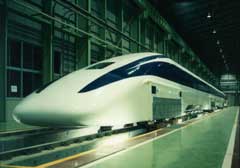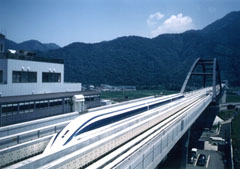
 |
||

|
Future Travel at 500 kph
 The superconducting magnetically levitated (Maglev) vehicle,
run by repulsive and attractive forces of superconducting magnets, has
no wheels or contact with the track and can thus travel at more than 500
kph (311 mph). Research and development of the Maglev started in 1962,
two years before the Tokaido Shinkansen Line was opened in 1964, and has
been led by the national government. After the Japan National Railways
was privatized and divided into six regional companies in 1987, the Railway
Technical Research Institute took over the project. In 1977, running tests
started at the 7-kilometer (4.3-mile) test track in Miyazaki Prefecture,
and construction of the larger, 42.8-kilometer (26.6-mile) test line in
Yamanashi was completed in 1996. Following many successful test runs, a
manned test run at the Yamanashi Maglev Test Line eventually cracked the
500-kph barrier on November 28, 1997, and a top speed of 531 kph (330 mph)
was reached on December 12. The final target, 550 kph (342 mph), was attained
in an unmanned test run on December 24, 1997.
 In order to confirm that the Maglev is suitable for practical use by the end of 1999, further studies on greater safety, reliability, and durability at 500 kph (311 mph), two-direction running, running in tunnels, and environmental impact tests are needed. At the Yamanashi Maglev Test Line, tests to address these challenging tasks are still underway. Photos: A Maglev vehicle running on the Yamanashi Test Line (Railway Technical Research Institute). Unauthorized reproduction of the
photos in this page is prohibited.
Related Links: |
|